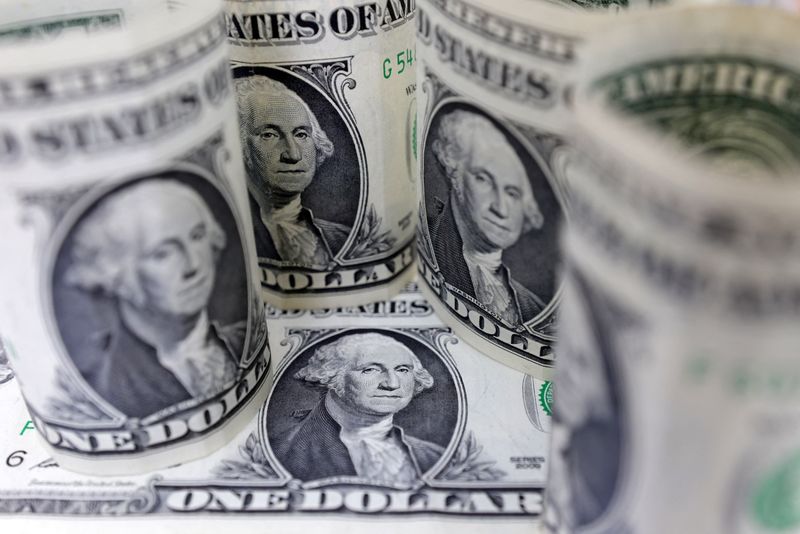Forex
Five charts on the Japanese yen’s decades-long drop

By Marc Jones
LONDON (Reuters) – Japan’s yen saw a sudden jump on Monday, suggesting the country’s authorities may have finally followed through on the FX market intervention warnings they have be making for months.
Monday’s moves follow a near-11% drop in the yen’s value against the dollar this year and a 35% slump over the last three decades that has pushed it to a 34-year low.
Here are five charts to show what has been happening.
1/INTERVENTION EFFORTS
Monday’s suspected intervention came after the yen dived past 160 to the dollar, well below where most FX traders had thought it would get to before the Bank of Japan reacted.
The last time authorities intervened was in September and October of 2022. They were estimated to have spent as much as 9.2 trillion yen ($60.78 billion) defending the currency at that time.
The other big effort came during the Asian financial crisis in 1998, when the yen lost almost 25% in just 14 months and reached nearly 148 per dollar in August that year. The United States joined in with the intervention push and the yen rallied over 35% in the following four months.
There has been intervention in the opposite direction too. In March 2011, Group of Seven (G7) nations jointly stepped in to stem yen strength when the currency spiked to a record high in the aftermath of a major earthquake that also crippled the large Fukushima nuclear plant.
2/TOKYO DRIFT
This isn’t a sudden thing. The yen has been universally weak over the last four years. Not only is it down 31% against the greenback over this period, it is down 29% against China’s currency, 29.5% against the euro and nearly 36% against the safe-haven Swiss franc.
remove ads
.
3/STOCK UP
The weak yen has been no bad thing for Japan’s stock market which is filled with companies that sell their products around the world. The weak yen keeps them competitive and has helped lift the market over 162% over the last decade, which is not far off the 174% rise the U.S. has seen over the same timeframe.
4/YIELD VS YEN
One of the main drivers of the yen’s weakness is that Japanese interest rates are far lower than elsewhere in the world. Benchmark 10-year U.S. government bonds, for example, currently yield 3.7 percentage points more than Japan’s.
This differential means it is not appealing for big international investors like pension funds to buy those Japanese government bonds, or JGBs as they are known, which it turn caps the demand for the yen.
Japan’s government debt-to-GDP ratio is also among the highest in the world, having more than trebled to close to 260% from 85% back in 1994.
5/WHERE WE ARE AT
The yen’s drop since the start of January is its third worst start to a year in the last three decades and the fifth time in the last six years that it has been down at this stage of the year.
Forex
BofA sees potential for further USD selling by CTAs

On Monday, Bank of America (BofA) provided insights into the potential actions of Commodity Trading Advisors (CTAs) in the coming week.
According to BofA, CTAs might continue to sell the U.S. dollar (USD) against most currencies following a trend that emerged after the Consumer Price Index (CPI) report led to a weakening dollar. The bank’s models indicate that USD long positions have been reduced this week.
The bank’s analysis suggests that in the foreign exchange (FX) market, CTAs are likely to persist with short covering in the euro (EUR), British pound (GBP), and Canadian dollar (CAD).
Additionally, there is an expectation for CTAs to increase their recently established long positions in the Australian dollar (AUD) and potentially initiate a long position in the Mexican peso (MXN), given the positive trend strength for the peso.
In the commodities sector, despite an increase in the price of gold last week, the trend for the precious metal declined, prompting CTAs to sell, albeit at a slower pace. BofA anticipates that this trend of selling gold and oil will continue into the next week.
The analysis also noted that CTAs’ long positions in are nearing extremely high levels, while long positions in aluminium are being unwound. In contrast, soybeans are experiencing short covering.
The bank’s report serves as a gauge of how trend-following traders might adjust their portfolios in response to market movements.
This article was generated with the support of AI and reviewed by an editor. For more information see our T&C.
Forex
BofA sees further dollar depreciation, expects G10 FX to stay in range

On Monday, Bank of America (BofA) analysts provided insights into the current state of G10 foreign exchange (FX) markets, noting a general sentiment of disappointment among investors due to the markets’ lack of volatility.
Despite a recent reversal in the U.S. dollar (USD), major currency pairs have not moved significantly, staying within their established ranges. BofA anticipates further depreciation of the USD, yet it emphasizes that the currency’s movements are expected to remain close to year-end consensus forecasts.
The analysis highlighted that while markets have expressed a desire for more excitement in G10 FX trading, they must come to terms with the inherent trade-off between carry trade opportunities and higher volatility. Carry trades, where investors borrow in low-yielding currencies to invest in higher-yielding ones, have been identified as a dominant trend post-global financial crisis.
However, this strategy tends to reduce market volatility, leading to what BofA describes as an “uninspiring” and “stuck in the mud” trading environment.
BofA’s commentary suggests that the pursuit of carry as a passive strategy has been a factor in dampening volatility in the FX markets. The firm underscores that investors should not expect both high carry returns and high volatility, as these market conditions are typically mutually exclusive. The lack of clear fundamental trends in G10 FX has been a source of frustration for markets, but the current trend of carry is clear, even if it leads to lower volatility.
The analysts also touched upon the anticipation around the next batch of U.S. data, which many investors hope might shift the narrative. However, BofA indicates that such expectations may be overly optimistic. The firm’s message to the markets is to adjust expectations and accept the current dynamics, with the USD continuing to play a central role in the G10 FX space.
In summary, BofA’s analysis points to a continuation of the recent patterns in G10 FX markets, with a slight downward trend in the USD value but within the bounds of recent trading ranges.
This article was generated with the support of AI and reviewed by an editor. For more information see our T&C.
Forex
Narrow dollar range likely to remain for now – Goldman

Investing.com – The U.S. dollar is trading in a calm fashion against the majors of late, and these narrow ranges will likely stay for a while longer, according to Goldman Sachs, with divergence having to wait.
AT 05:20 ET (09:20 GMT), the Dollar Index, which tracks the greenback against a basket of six other currencies, traded unchanged at 104.330, steadying after losing around 1% last week in the wake of soft U.S. inflation data.
“We think there is only limited room for the market to press Dollar shorts on the back of the inflation news,” said analysts at Goldman Sachs, in a note dated May 17.
“After all, while the prints were mostly in line with expectations, they were not in line with the target. As a result, the news does not change the policy outlook much beyond reinforcing the recent rhetoric.”
The subsequent market response has been reminiscent of the post-March FOMC FX reaction, when the response to ‘dovish dots’ stalled not because of fresh data, but instead because FX is still a relative game, and the Dollar fundamentals have not shifted much, the investment bank added.
And, this time around, we think the rally in front end rates looks more consistent with cyclical concerns rather than dovish expectations.
“That matters for FX because there is a narrow path for the Dollar to depreciate on a broad basis when growth is softening,” the bank added. “This is especially true in the current environment when faster Fed cuts would likely be met with easier policy abroad as well.”

 Forex2 years ago
Forex2 years agoForex Today: the dollar is gaining strength amid gloomy sentiment at the start of the Fed’s week

 Forex2 years ago
Forex2 years agoHow is the Australian dollar doing today?

 Forex1 year ago
Forex1 year agoUnbiased review of Pocket Option broker

 Forex2 years ago
Forex2 years agoDollar to pound sterling exchange rate today: Pound plummeted to its lowest since 1985

 Cryptocurrency2 years ago
Cryptocurrency2 years agoWhat happened in the crypto market – current events today

 World2 years ago
World2 years agoWhy are modern video games an art form?

 Stock Markets2 years ago
Stock Markets2 years agoMorgan Stanley: bear market rally to continue

 Economy2 years ago
Economy2 years agoCrude oil tankers double in price due to EU anti-Russian sanctions

































